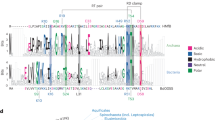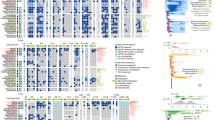Abstract
Archaeal histones from mesophilic, thermophilic, and hyperthermophilic members of the Euryarchaeota have primary sequences, the histone fold, tertiary structures, and dimer formation in common with the eukaryal nucleosome core histones H2A, H2B, H3, and H4. Archaeal histones form nucleoprotein complexes in vitro and in vivo, designated archaeal nucleosomes, that contain histone tetramers and protect approximately 60 base pairs of DNA from nuclease digestion. Based on the sequence and structural homologies and experimental data reviewed here, archaeal nucleosomes appear similar, and may be homologous in evolutionary terms and function, to the structure at the center of the eukaryal nucleosome formed by the histone (H3+H4)2 tetramer.
Similar content being viewed by others
Author information
Authors and Affiliations
Additional information
Received: January 22, 1998 / Accepted: February 16, 1998
Rights and permissions
About this article
Cite this article
Pereira, S., Reeve, J. Histones and nucleosomes in Archaea and Eukarya: a comparative analysis. Extremophiles 2, 141–148 (1998). https://doi.org/10.1007/s007920050053
Issue Date:
DOI: https://doi.org/10.1007/s007920050053




